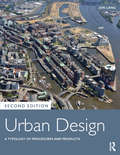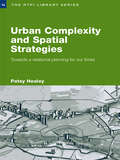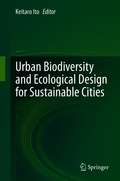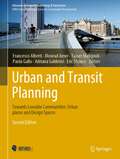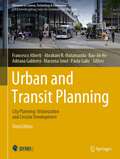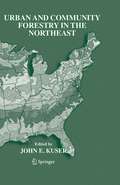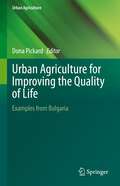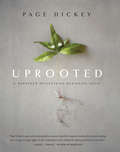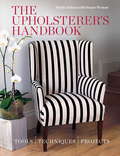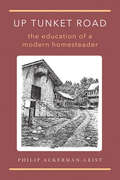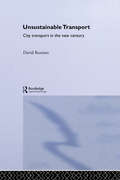- Table View
- List View
Urban Design: A Typology of Procedures and Products
by Jon LangUrban Design: A Typology of Procedures and Products, 2nd Edition provides a comprehensive and accessible introduction to urban design, defining the field and addressing the controversies and goals of urban design. Including over 50 updated international case studies, this new edition presents a three-dimensional model with which to categorize the processes and products involved: product type, paradigm type, and procedural type. The case studies not only illuminate the typology but provide information that designers can use as precedents in their own work. Uniquely, these case study projects are framed by the design paradigm employed, categorized by procedural type instead of instrumental or land use function. The categories used here are Total Urban Design, All-of-a-piece Urban Design, Plug-in Urban Design, and Piece-by-piece Urban Design.Written for both professionals and those encountering urban design in their day-to-day life, Urban Design is an essential introduction to the field and practice, considering the future direction of the field and what can be learned from the past.
Urban Design: Street And Square (Urban Design Ser.)
by Cliff MoughtinThis book, part of a series of four, offers a detailed analysis of urban design, covering the streets, squares and buildings that make up the public face of towns and cities. It outlines the theory of the principal features of urban design from which method is developed and provides a better understanding of the main elements of urban design. This includes the arrangement, design and details of the streets and squares, and the roles they play in city planning.This third edition includes chapters on "Sustainable Urban Design" and "Visual Analysis", introducing the latest theories and influences in the field and bringing greater practical significance to the book. Cliff Moughtin explores the street and square in terms of function, structure and symbolism and examines fine examples in their historical context. These are set against the background of the laws of urban design composition, culled from Renaissance and modern writers.
The Urban Contract: Community, Governance and Capitalism
by Paolo PerulliToday, the increasing mobility of capital, people and information has changed the space relations of urban societies. Contractual relations have increased in every field of social life: in the economic field, but also in the political, and in creative and scientific areas. Contracts are not only legal frameworks or economic aggregates of individuals, but socially embedded forms. The concept of urban contract proposed in this book combines the theoretical body of economic-juridical literature on the contract with that of historical-anthropological and socio-spatial literature on the city. Through a diverse range of ten city case studies, The Urban Contract compares European, North-American and Asian Urban Contracts. It concludes with a theoretical proposal for understanding the deep dialectical nature of Contract Cities: their reciprocity and competition, their dual trend towards growth and decay, their cyclical nature as agents of change and disruption of the social forms of urbanity.
The Urban Contract: Community, Governance and Capitalism
by Paolo PerulliToday, the increasing mobility of capital, people and information has changed the space relations of urban societies. Contractual relations have increased in every field of social life: in the economic field, but also in the political, and in creative and scientific areas. Contracts are not only legal frameworks or economic aggregates of individuals, but socially embedded forms. The concept of urban contract proposed in this book combines the theoretical body of economic-juridical literature on the contract with that of historical-anthropological and socio-spatial literature on the city. Through a diverse range of ten city case studies, The Urban Contract compares European, North-American and Asian Urban Contracts. It concludes with a theoretical proposal for understanding the deep dialectical nature of Contract Cities: their reciprocity and competition, their dual trend towards growth and decay, their cyclical nature as agents of change and disruption of the social forms of urbanity.
Urban Connections in the Contemporary Pedestrian Landscape
by Philip PregillUrban Connections in the Contemporary Pedestrian Landscape explores the significant physical and cultural changes in our urban areas following the implementation of design strategies and increased pedestrian activity. Beginning with a history of the urban grid, the book then discusses experiential factors of pedestrianized urban landscapes in three scales, arterials, collectors and locals, with an emphasis on inductive and deductive design alternatives. It closely examines elements derived from current urban pedestrian experiences including form, scale, surfaces and identity and provides alternative design solutions for the future. Uniquely focusing on a hierarchical discussion of the quality of contemporary landscape design applications within the urban grid, and with illustrated examples throughout the text, this will be useful recommended reading for academics, researchers and postgraduate students on urban landscape and design courses.
Urban Connections in the Contemporary Pedestrian Landscape
by Philip PregillUrban Connections in the Contemporary Pedestrian Landscape explores the significant physical and cultural changes in our urban areas following the implementation of design strategies and increased pedestrian activity. Beginning with a history of the urban grid, the book then discusses experiential factors of pedestrianized urban landscapes in three scales, arterials, collectors and locals, with an emphasis on inductive and deductive design alternatives. It closely examines elements derived from current urban pedestrian experiences including form, scale, surfaces and identity and provides alternative design solutions for the future. Uniquely focusing on a hierarchical discussion of the quality of contemporary landscape design applications within the urban grid, and with illustrated examples throughout the text, this will be useful recommended reading for academics, researchers and postgraduate students on urban landscape and design courses.
Urban Complexity and Spatial Strategies: Towards a Relational Planning for Our Times (RTPI Library Series)
by Patsy HealeyUrban Complexity and Spatial Strategies develops important new relational and institutionalist approaches to policy analysis and planning, of relevance to all those with an interest in cities and urban areas. Well-illustrated chapters weave together conceptual development, experience and implications for future practice and address the challenge of urban and metropolitan planning and development. Useful for students, social scientists and policy makers, Urban Complexity and Spatial Strategies offers concepts and detailed cases of interest to those involved in policy development and management, as well as providing a foundation of ideas and experiences, an account of the place-focused practices of governance and an approach to the analysis of governance dynamics. For those in the planning field itself, this book re-interprets the role of planning frameworks in linking spatial patterns to social dynamics with twenty-first century relevance.
Urban Complexity and Spatial Strategies: Towards a Relational Planning for Our Times (RTPI Library Series)
by Patsy HealeyUrban Complexity and Spatial Strategies develops important new relational and institutionalist approaches to policy analysis and planning, of relevance to all those with an interest in cities and urban areas. Well-illustrated chapters weave together conceptual development, experience and implications for future practice and address the challenge of urban and metropolitan planning and development. Useful for students, social scientists and policy makers, Urban Complexity and Spatial Strategies offers concepts and detailed cases of interest to those involved in policy development and management, as well as providing a foundation of ideas and experiences, an account of the place-focused practices of governance and an approach to the analysis of governance dynamics. For those in the planning field itself, this book re-interprets the role of planning frameworks in linking spatial patterns to social dynamics with twenty-first century relevance.
Urban Coding and Planning (Planning, History and Environment Series)
by Stephen MarshallUrban codes have a profound influence on urban form, affecting the design and placement of buildings, streets and public spaces. Historically, their use has helped create some of our best-loved urban environments, while recent advances in coding have been a growing focus of attention, particularly in Britain and North America. However, the full potential for the role of codes has yet to be realized. In Urban Coding and Planning, Stephen Marshall and his contributors investigate the nature and scope of coding; its purposes; the kinds of environments it creates; and, perhaps most importantly, its relationship to urban planning. By bringing together historical and ongoing traditions of coding from around the world – with chapters describing examples from the United Kingdom, France, India, China, Japan, Australia, South Africa, the United States and Latin America – this book provides lessons for today’s theory and practice of place-making.
Urban Coding and Planning (Planning, History and Environment Series)
by Stephen MarshallUrban codes have a profound influence on urban form, affecting the design and placement of buildings, streets and public spaces. Historically, their use has helped create some of our best-loved urban environments, while recent advances in coding have been a growing focus of attention, particularly in Britain and North America. However, the full potential for the role of codes has yet to be realized. In Urban Coding and Planning, Stephen Marshall and his contributors investigate the nature and scope of coding; its purposes; the kinds of environments it creates; and, perhaps most importantly, its relationship to urban planning. By bringing together historical and ongoing traditions of coding from around the world – with chapters describing examples from the United Kingdom, France, India, China, Japan, Australia, South Africa, the United States and Latin America – this book provides lessons for today’s theory and practice of place-making.
Urban Biodiversity and Ecological Design for Sustainable Cities
by Keitaro ItoThis book highlights various designs for urban green spaces and their functions. It provides an interesting meeting point between Asian, European and North America specialists (researchers, planners, landscape architects) studying urban biodiversity; urban biodiversity and green space; relations between people and biodiversity. The most important feature of this book is the unique point of view from each contributor towards “the relationship between nature and people in urban areas”, in the context of the ecosystem and biodiversity in urban areas and how to manage them. All chapters explore and consider the relationship between humans and nature in cities, a subject which is taking on increasing importance as new cities are conceptualized and planned. These discussion and examples would be useful for urban ecology researchers, biologists, city planners, government staff working in city planning, architects, landscape architects, and university instructors. This book can also be used as a textbook for undergraduate and postgraduate city planning, architecture or landscape architecture courses.
Urban and Transit Planning: Towards Liveable Communities: Urban places and Design Spaces (Advances in Science, Technology & Innovation)
by Francesco Alberti Mourad Amer Yasser Mahgoub Paola Gallo Adriana Galderisi Eric StraussThis book incorporates a wealth of research focused on the more and more urgent challenges that urban planning and architectural design all over the world must cope with: from climate change to environmental decay, from an increasing urban population to an increasing poverty. In detail, this book aims at providing innovative approaches, tool and case study examples that, in line with the agenda of 2030, may better drive human settlements toward a sustainable, inclusive and resilient development. To this aim, the book includes heterogeneous regional perspectives and different methodologies and suggests development models capable of limiting further urban growth and re-shaping existing cities to improve both environmental quality and the overall quality of life of people, also taking account the more and more close relationships among urban planning and technological innovation.
Urban and Transit Planning: City Planning: Urbanization and Circular Development (Advances in Science, Technology & Innovation)
by Francesco Alberti Abraham R. Matamanda Bao-Jie He Adriana Galderisi Marzena Smol Paola GalloThis book represents a compilation of research in sustainable architecture and planning. Its main focus is offering strategies and solutions that help reducing of the negative impacts of buildings on the environment and emphasizing the suitable management of available resources. By tackling the topic of sustainability from a historical perspective and also as a vision for the future, the book in hands provides new horizons for engineers, urban planners and environmentalists interested in the optimization of resources, space development, and the ecosystem as a whole to address the complex unresolved problems our cities are facing. This book is a culmination of selected research papers from IEREK’s sixth edition of the International Conference on Urban Planning & Architectural Design for Sustainable Development (UPADSD) held online in collaboration with the University of Florence, Italy (2021) and the first edition of the International Conference on Circular Economy for Sustainable Development (CESD) held online in collaboration with the University of Salento, Lecce, Italy (2021).
Urban and Community Forestry in the Northeast
by John E. KuserThis book is a textbook for Urban/Community Forestry courses and a handbook for Shade Tree Commissions, tree wardens, State and National Forestry Services, and professional societies. It is the most complete text in this field because it addresses both culture and management, and the chapters have been written by experts who are active practitioners. The book provides observations and examples relevant to every urban center in the U.S. and elsewhere.
Urban Allotment Gardens in Europe
by Mary Benson Simon Bell Susan Noori Runrid Fox-Kämper Nazila Keshavarz Silvio Caputo Annette VoigtAlthough urban allotment gardening dates back to the nineteenth century, it has recently undergone a renaissance of interest and popularity. This is the result of greater concern over urban greenspace, food security and quality of life. This book presents a comprehensive, research-based overview of the various features, benefits and values associated with urban allotment gardening in Europe. The book is based on a European COST Action project, which brings together researchers and practitioners from all over Europe for the first detailed exploration of the subject on a continent-wide scale. It assesses the policy, planning and design aspects, as well as the social and ecological benefits of urban allotment gardening. Through an examination of the wide range of different traditions and practices across Europe, it brings together the most recent research to discuss the latest evolutions of urban allotment gardening and to help raise awareness and fill knowledge gaps. The book provides a multidisciplinary perspective, including insights from horticulture and soil science, ecology, sociology, urban geography, landscape, planning and design. The themes are underpinned by case studies from a number of European countries which supply a wide range of examples to illustrate different key issues.
Urban Allotment Gardens in Europe
by Mary Benson Simon Bell Susan Noori Runrid Fox-Kämper Nazila Keshavarz Silvio Caputo Annette VoigtAlthough urban allotment gardening dates back to the nineteenth century, it has recently undergone a renaissance of interest and popularity. This is the result of greater concern over urban greenspace, food security and quality of life. This book presents a comprehensive, research-based overview of the various features, benefits and values associated with urban allotment gardening in Europe. The book is based on a European COST Action project, which brings together researchers and practitioners from all over Europe for the first detailed exploration of the subject on a continent-wide scale. It assesses the policy, planning and design aspects, as well as the social and ecological benefits of urban allotment gardening. Through an examination of the wide range of different traditions and practices across Europe, it brings together the most recent research to discuss the latest evolutions of urban allotment gardening and to help raise awareness and fill knowledge gaps. The book provides a multidisciplinary perspective, including insights from horticulture and soil science, ecology, sociology, urban geography, landscape, planning and design. The themes are underpinned by case studies from a number of European countries which supply a wide range of examples to illustrate different key issues.
Urban Agriculture for Improving the Quality of Life: Examples from Bulgaria (Urban Agriculture)
by Dona PickardThis book presents the findings of a multidisciplinary study on the effects of urban agriculture (UA) on the social, economic and environmental aspects of the quality of life in Sofia - the capital of Bulgaria. The analyses are based on a sociological survey representative of 3 districts of Sofia (among 750 people), in-depth interviews, focus groups, expert statements, ecological monitoring of UA sites, and spatial mapping of natural resources for UA. It also focuses on UA effects on the social well-being of citizens and communities, the correlation between social capital and UA attitudes, the challenges for UA to integrate disadvantaged social groups, the factors for success of small UA businesses, as well as the role of policy and civil society in developing UA. This work is also important for the analysis of the underlying links between all aspects of urban agriculture, many of which are valid beyond the local socio-economic context and environmental specifics of the city of Sofia.
Uprooted: A Gardener Reflects on Beginning Again
by Page DickeyThe engaging story of leaving a beloved garden and creating a new, very different garden, by one of America&’s best-known and most accomplished garden writers.
The Upholsterer's Step-by-Step Handbook: A Practical Reference
by Alex LawThe Upholsterer's Step-by-step Handbook reveals the techniques and tips of the upholstery trade in an easy to understand format. Fully illustrated throughout with informative illustrations and inspiring photography, this book will enable you to confidently create a statement piece of furniture for your home.
The Upholsterer's Handbook
by Nicole Fulton Stuart WestonIn eye-capturing style The Upholsterer's Handbook offers everything you need and more, in order to prepare and inspire you to create beautifully upholstered furniture. The upholstered pieces range in skill level from simple seats to more complex items such as a button-back chair. Various styles of furniture are covered, from classic and elegant to other more styled and designer pieces.The Upholsterer's Handbook opens with sections on sourcing furniture, tools and materials, and choosing fabrics - including finishes and trimmings, which are often the key to the success of a piece. With special photography throughout, basic techniques are illustrated step-by-step, from stripping back to top stuffing to making cushions. 18 stunning projects are featured with varying skill levels, covering such diverse items as a G-plan chair, a sofa, a '70s flower-shaped stool, dining chairs, and headboards. Throughout Nicole Fulton demonstrates techniques using linen, satin, velvet, leather, cowhide, and other fabrics that give the furniture a unique contemporary look.
Upcycling Furniture & Home Decor For Dummies
by Judy RomBreathe new life into old furniture and thrift store finds Upcycling Furniture For Dummies shows you how to revitalize old furniture, with just a little effort and imagination, and maybe a few coats of fresh paint. Upcycling furniture is affordable, good for the environment, and a whole lot of fun! This easy, step-by-step guide shows you how to get creative and put your own unique flair on your designs. You'll gain the knowledge and confidence you need to select items that are worth transforming or restoring and learn specific techniques to give old pieces a new lease on life. Learn the process of upcycling dressers, tables, chairs, and other furniture Enjoy the fun of sourcing items and increasing their value with your creativity! Update your décor with gorgeous, upcycled furniture Express yourself and find out how to flip your creations for a profit! This Dummies reference is great for anyone with an interest in turning trash into treasure.
Upcycling Furniture & Home Decor For Dummies
by Judy RomBreathe new life into old furniture and thrift store finds Upcycling Furniture For Dummies shows you how to revitalize old furniture, with just a little effort and imagination, and maybe a few coats of fresh paint. Upcycling furniture is affordable, good for the environment, and a whole lot of fun! This easy, step-by-step guide shows you how to get creative and put your own unique flair on your designs. You'll gain the knowledge and confidence you need to select items that are worth transforming or restoring and learn specific techniques to give old pieces a new lease on life. Learn the process of upcycling dressers, tables, chairs, and other furniture Enjoy the fun of sourcing items and increasing their value with your creativity! Update your décor with gorgeous, upcycled furniture Express yourself and find out how to flip your creations for a profit! This Dummies reference is great for anyone with an interest in turning trash into treasure.
Upcycling: Create Beautiful Things with the Stuff You Already Have
by Danny SeoRenowned environmental lifestyle expert and Today Show regular Danny Seo shares 100 of his most inspiring projects for creative transformation. Have neglected items around your house? They can be the source for exciting craft possibilities! Turn your old leather belts into a cool doormat (or even a briefcase!); worn-out paperbacks into gorgeous bud vases; tennis balls into a quaint country swing; chopsticks into a handsome trivet, and many more.With full-color photos throughout to guide and inspire, Danny shows that it's easy to be crafty, and fun to be budget- and eco-conscious.
Up Tunket Road: The Education of a Modern Homesteader
by Philip Ackerman-Leist Erin Ackerman-LeistEver since Thoreau's Walden, the image of the American homesteader has been of someone getting away from civilization, of forging an independent life in the country. Yet if this were ever true, what is the nature and reality of homesteading in the media-saturated, hyper-connected 21st century? For seven years Philip Ackerman-Leist and his wife, Erin, lived without electricity or running water in an old cabin in the beautiful but remote hills of western New England. Slowly forging their own farm and homestead, they took inspiration from their experiences among the mountain farmers of the Tirolean Alps and were guided by their Vermont neighbors, who taught them about what it truly means to live sustainably in the postmodern homestead--not only to survive, but to thrive in a fragmented landscape and a fractured economy. Up Tunket Road is the inspiring true story of a young couple who embraced the joys of simple living while also acknowledging its frustrations and complexities. Ackerman-Leist writes with humor about the inevitable foibles of setting up life off the grid--from hauling frozen laundry uphill to getting locked in the henhouse by their ox. But he also weaves an instructive narrative that contemplates the future of simple living. His is not a how-to guide, but something much richer and more important--a tale of discovery that will resonate with readers who yearn for a better, more meaningful life, whether they live in the city, country, or somewhere in between.
Unsustainable Transport: City Transport in the New Century (Transport, Development and Sustainability Series)
by David BanisterThis book addresses the links between transport and sustainable urban development, from an analysis of the global picture to issues in transport and energy intensity, public policy and the institutional and organisational constraints on change. The central part of the book explores these links in more detail at city level, covering land use and development, economic measures, and the role that technology can play. The final part looks for inspiration from events in developing countries and the means by which we can move from the unsustainable present to a more sustainable future.
